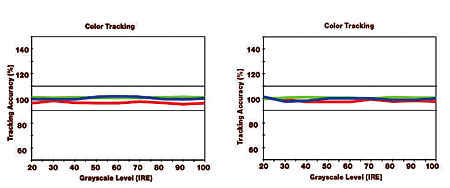Samsung UN55B7000 LCD TV Measurements
Full-On/Full-Off Contrast Ratio: 15,715:1
All the measurements here were taken in the Movie mode, adjusted for the most accurate picture. The Contrast was set to 85, the Brightness to 47, the Backlight to 3 (out of 10) and the Gamma to 0. The Energy Saving control was on Low.
The full-on/full-off contrast ratio, sometimes referred to as the peak contrast ratio, sequential contrast ratio, or dynamic range, is superb for an LCD. The set is capable of dramatically higher brightness (72.6 foot-lamberts in the factory Dynamic mode and 52 ft-L in the factory Stan- dard mode—in each case with a black level that still hovered around that impressive 0.002 ft-L), but you really won’t need it. The picture looked best in its calibrated Movie mode.
The Color Tracking charts below show how well a display adheres to the D65 standard white point; the tighter the overlap of the three primary colors, the nearer the result is to D65. Both charts were taken in the Warm2 Color Tone setting. The pre-calibration result in this sample is exceptionally good. It’s a bit better post calibration, but there wasn’t much room for improvement.

As seen in the CIE chart at left, taken in the Color Space Auto mode, Samsung deserves a medal for providing an accurate Rec.709 color gamut out of the gate, in a market where pumped-up color gamuts are common. The brightness levels of the individual colors were a bit off from standard values (not visible in the chart). Green was a little too intense, and blue and red were a bit short of the desired brightness. But the deviations were not enough to impact the color quality in any obvious way. I tried calibrating the Custom Color Space mode, but the result was arguably no better—in fact, it was worse in some ways—and it was far more tedious to accomplish with the needed calibration tools.

The Samsung’s luma (black and white) and chroma (color) resolution were outstanding in 1080i (measured in both HDMI and component) and 1080p (measured in HDMI). The 720p resolution was good in HDMI but only fair in component. The 480i resolution was excellent in HDMI and good in component. In all cases, the Samsung’s response extended up to the maximum test burst frequencies for each resolution (37.1 megahertz for HD). The only difference between the excellent, good, and fair ratings was the increasing degree of visible rolloff at the highest burst frequency.
Overscan was low to nonexistent at 1080p (HDMI measured), 1080i (HDMI and component), and 720p HDMI, never exceeding 0.5 percent per side (with the Size option set to Screen Fit). The 720p component overscan averaged 2.5 percent per side (about a 10-percent loss of overall image area). In 480i/p (HDMI and component), it measured 3 percent per side (a 12-percent overall loss).—TJN
- Log in or register to post comments





























































